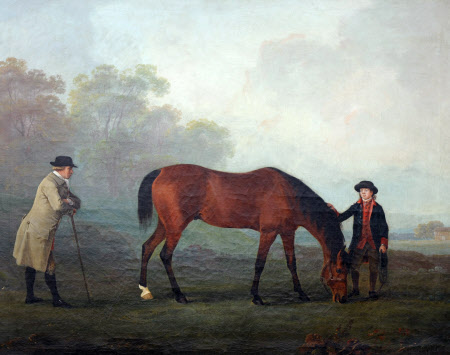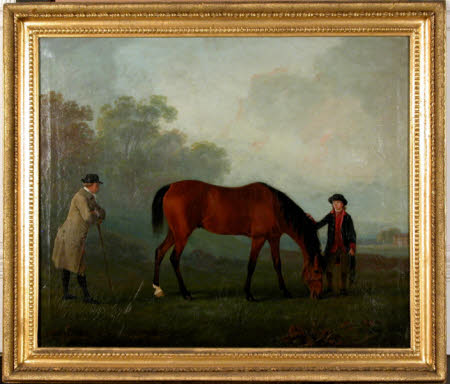'Furiband', with his Owner, Sir Henry ‘Harry’ Harpur, 6th Bt (1739-1789) and a Groom
Sawrey Gilpin, RA (1733 - 1807)
Category
Art / Oil paintings
Date
1774 (signed and dated)
Materials
Oil on canvas
Measurements
616 x 743 mm (24 1/4 x 29 1/4 in)
Order this imageCollection
Calke Abbey, Derbyshire
NT 290362
Caption
The cult of the horse has been strong at Calke ever since the 17th century. The 'Harpur Arabian' established one of the founding lines of British bloodstock; and the house is so stuffed with horse-pictures that some — including this one — even hang in the Library. Gilpin was as celebrated a horse-painter as Stubbs in his own day, and even sometimes preferred to him, because of his ability to 'elevate' the genre. Here, figures and horse form a classical frieze, whilst Sir Harry's pose echoes that of figures in the Medici vase.
Summary
Oil painting on canvas, 'Furiband', with his Owner, Sir Henry ‘Harry’ Harpur, 6th Bt (1739-1789) and a Groom by Sawrey Gilpin, RA (Scalesby Castle 1733 – Brompton 1807), signed dated lower right, 'S. Gilpin 1774'. A light bay hunter is shown in a field, facing right, a groom at its head and the owner behind. The owner wears a grey coat and black hat and stockings, and he leans on a stick. The horse is grazing in a head collar. The groom wears a red waistcoat and navy coat lined with red. A barn is in the landscape background. In a gilt moulded frame en suite with CAL/Pf/180, CAL/Pf/181 and CAL/Pf/182 (Inventory card). This is one of four paintings at Calke by Sawrey Gilpin, the chief rival of George Stubbs. With Nos. CAL/P/180, CAL/P/181 and CAL/P/183 it depicts Sir Harry Harpur's best racehorse. the figure on the left is Sir Harry Harpur, 6th Bt.
Full description
It is hard to imagine ourselves back to a time when Gilpin and his slightly older contemporary, George Stubbs (1724-1806) were regarded as evenly-matched rivals, and when Gilpin could sometimes even be given the preference. That Gilpin was a full RA, and Stubbs only an ARA cannot really be regarded as a reflection of this imagined superiority (though it may, in the minds of the uninformed, have contributed to it), since Stubbs was elected a full Academician as early as 1781, but then refused to comply with a rule made only after his election, that Academicians should deposit a diploma work with the Academy; Gilpin, by contrast, missed election even as an Associate in 1789, because the casting vote by Reynolds (who had bought a horse-painting off Stubbs for 100 gns.) went in favour of the architect Joseph Bonomi, and was only elected ARA in 1795, and RA in 1797. Previously, first Stubbs (1772 & 1773), then he (1733 & 1774), had been successively elected President and then Director of the Incorporated Society of Artists. If Gilpin was rated by contemporaries as highly as Stubbs, it was because both were seen primarily as horse-painters, and were narrowly judged, above all, by their handling of that main motif. If he was sometimes assessed more highly, it was because, in the efforts that both painters made to be accepted as more than mere horse-painters, which meant finding 'historical' subjects with horses - to do with Hercules, Phaeton, Darius, or Gulliver - that enabled them to deploy their speciality in the 'highest' form of their art, history-painting, Gilpin (who executed a succession of such subjects at the Society of Artists in the years of, and immediately following, the foundation of the Royal Academy) was prepared, as Stubbs was not, to imbue the horses themselves with those expressions of sentiment and emotion in which, deployed with humans, the superiority of history-painting was thought to reside. This attitude transpires most clearly from the comparative assessment made by an intelligent fellow-artist, Prince Hoare: "Gilpin, less anatomically learned than Stubbs, gave to inferiour animals of every description, not only the forms of simplicity and truth, but added a grace and sentiment, which seemed to rank them in a higher class of intellect" . Sadly, although one of Stubbs's most poetic treatments of horses, the frieze of Five Mares in a Park (1760s, Ascott), and an exceptional work of his old age, Hambletonian, Rubbing Down (1800, Mount Stewart), are both in National Trust houses, each is too fragile to travel to this exhibition. It is, however, some slight compensation to be able to show a work of Gilpin's , dating from the year of his directorship of the Society of Artists (though only shown the succeeding year), devoid of the sometimes inappropriate ambitions that the Royal Academy encouraged, and one in which he comes nearest to the strengths of Stubbs in those years. For what we, less equinely obsessed, observers have come to see as one of the great strengths of Stubbs, in addition to his skills as an animal-painter, is his observation of the human companions of his horses. In particular, he gave to hunt servants, grooms, and stable-lads a dignity usually denied to them or their equivalents in paintings that were overtly of rustic life. In the present picture, whilst the horse grazes in the centre of the composition, almost as if it were conscious that it is the cynosure of every eye, the snub-nosed groom unselfconsciously places a trusting hand upon its neck, whilst its owner contemplates it, totally absorbed, and leaning on his stick in an attitude that curiously mirrors that of the horse's rump and hind legs, but which is in fact borrowed from an Antique source. We have kept until last the information about the horse that would actually have been the prime interest of the picture for most of those who looked at it immediately after it was painted. 'Furiband' was foaled in 1767 by 'Squirrel' out of Lady-thigh' . Bred by Duke of Anacaster, he was sold three times, until 1772, when he was bought by Sir Harry Harpur, 6th Bt (1739-89), he largely raced and won at Newmarket. He won for Sir Harry at Notinham and Spaldin in 1772, Burford in 1773 and at Stamford, Strayford and Warwick in 1774. He was to win again at Warwick and at Maidenhead in 1775, but by 1777 hae had been sold to Mr Moody. The picture is one of four racehorses painted by Gilpin for Sir Harry in 1774 (the others are 'Jason' with a Groom, 'Pilot' with Jockey up, and 'Juniper' held by a Groom, with the Doncaster Gold Cup displayed), that are in the library at Calke - a room hung, unusually for a library in England, exclusively with horseflesh. This may reflect the historic importance of horses for Calke, where there had been a stud since the 17th century, and to which one of the founding horses of racing bloodlines, 'the Harpur Arabian', had been brought by Sir John Harpur, 4th Bt (1680-1741) at the beginning of the century. The payments for both the pictures and their frames are recorded in the Calke Account Book under 1775: "Pd. Mr. Gilpin for painting 4 houses [sic] £68.5s" and "Pd. Mr. Vials for 4 frames for the hourse [sic] painted by Mr. Gilpin £7.7s.". Interestingly, "Mr. Vial's, Leicester Fields" was the contact address in London that Gilpin gave in the catalogue of the Society of Artists for 1765 (just as William Marlow did from 1763 to 1778), when he was living at Windsor, painting the Duke of Cumberland's horses. Thomas Vial or Vialls (active 1756 -d. 1779/80), was one of the most distinguished frame-makers of his day, furnishing frames to numerous great houses and - his swan-song - to the Dilettanti Society for its pair of Reynolds portraits of its members . (i) Epochs of the Arts, 1813, p.169. (ii) I am most grateful to Dr Catherine Wills for this and the following equine information. (iii) Dictionary of English Furniture Makers 1660-1840, ed. Geoffrey Beard & Christopher Gilbert, 1986, p.922, s.v. I owe the reference to Marlow giving Viall's address to the kindness of Lucy Wood. (adapted from author's version/pre-publication, Alastair Laing, In Trust for the Nation, exh. cat., 1995)
Marks and inscriptions
S. Gilpin 1774 (inscribed lower right)
Makers and roles
Sawrey Gilpin, RA (1733 - 1807), artist
Exhibition history
In Trust for the Nation, National Gallery, London, 1995 - 1996, no.23

